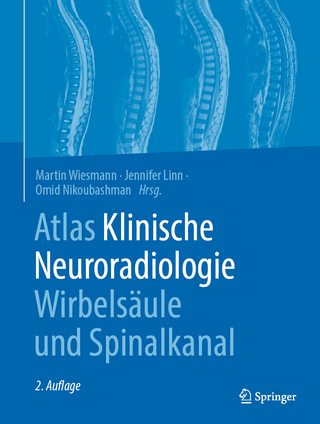
Intrinsic and Skull Base Tumors
Elsevier - Health Sciences Division (Verlag)
978-0-323-69642-5 (ISBN)
Offers 3 to 4 expert opinions on each case in a templated format designed to help you quickly make side-by-side comparisons-an ideal learning tool for both trainees and practicing neurosurgeons for board review and case preparation.
Helps you easily grasp different approaches to brain tumor management with different expert approaches to the same case and summaries from the editors on the advantages and disadvantages to each approach.
Features a wide variety of management decisions, from preoperative studies to surgical approach, surgical adjuncts, and postoperative care, from experts in the field who specialize in different aspects of neurosurgery.
Covers low and high grade gliomas, metastatic brain cancers, meningiomas, sellar and parasellar lesions, skull base lesions, and other brain lesions such as colloid cyst, cavernoma, hemangioblastoma, brain abscess, and more.
Enhanced eBook version included with purchase. Your enhanced eBook allows you to access all of the text, figures, and references from the book on a variety of devices.
Kaisorn L. Chaichana has completed a fellowship in skull base surgery and Neuro-Oncology. He has published over 100 papers and 20 book chapters in areas relating to neuro-oncology, namely gliomas and metastatic brain tumors. He has clinical expertise in neuro-oncological surgery, including minimally invasive surgery for treatment of intrinsic neoplasms. Alfredo Quinones-Hinojosa has edited several books including Schmidek and Sweet: Operative Neurosurgical Techniques, Controversies in Neuro-Oncology: Best Evidence Medicine for Brain Tumor Surgery, and Video Atlas of Neurosurgery: Contemporary Tumor and Skull Base Surgery, and Neural Stem Cells (An Issue of Neurosurgery Clinics). He has clinical expertise in Neuro-Oncology, tumor surgery, and is a world authority on these aspects of Neuro-Oncology.
I. Introduction
II. Supratentorial intrinsic neoplasm
a. Low grade gliomas
i. Right frontal pole low grade glioma
ii. Right peri-Rolandic low grade glioma
iii. Left peri-Rolandic high grade glioma
iv. Left Broca's area low grade glioma
v. Left Wernicke's area low grade glioma
vi. Right insular low grade glioma
vii. Left insular low grade glioma
viii. Occipital lobe low grade glioma
ix. Gliomatosis cererbi
b. High grade gliomas
i. Right frontal pole high grade glioma
ii. Right peri-Rolandic high grade glioma
iii. Left peri-Rolandic high grade glioma
iv. Left Broca's area high grade glioma
v. Left Wernicke's area high grade glioma
vi. Right insular high grade glioma
vii. Left insular high grade glioma
viii. Occipital lobe high grade glioma
ix. Left thalamic high grade glioma
x. Left basal ganglia high grade glioma
xi. Recurrent high grade glioma
c. Metastatic tumors
i. Peri-Rolandic metastasis
ii. 2 metastases
iii. 3 metastases
iv. Basal ganglia metastasis
v. Multiple metastases but one is symptomatic
vi. Intraventricular metastasis
vii. Sellar metastasis
d. Other lesions
i. Peri-Rolandic abscess
ii. Temporal arachnoid cyst
iii. Sphenoid encephalocele
III. Infratentorial intrinsic neoplasm
i. Cerebellar metastasis
ii. Cerebellar hemangioblastoma
iii. Middle cerebellar peduncle cavernoma
iv. Vermian metastasis
v. Medullary non exophytic glioma
vi. Medullary exophytic glioma
IV. Intraventricular lesions
i. Colloid cyst
ii. Intraventricular meningioma
iii. Central neurocytoma
iv. Craniopharyngioma with extension into the 3rd ventricule
v. 4th ventricular ependymoma
vi. Choroid plexus papilloma
vii. Medulloblastoma
V. Anterior fossa skull base lesions
i. Olfactory groove meningioma
ii. Esthesioneuroblastoma
iii. Parasagittal meningioma
iv. Parafalcine meningioma
v. Pituitary adenoma
vi. Skull base metastasis
vii. Craniopharyngioma
VI. Middle fossa skull base lesions
i. Medial sphenoid wing meningioma
ii. Lateral sphenoid wing meningioma
iii. Cavernous sinus meningioma
VII. Posterior fossa skull base lesions
i. Vestibular schwannoma
ii. CPA meningioma
iii. Petro-clival meningioma
VIII. Sinonasal malignancies
i. Squamous cell carcinoma
ii. Juvenile nasopharyngeal fibroma
iii. Sinonasal undifferentiated carcinoma
| Erscheinungsdatum | 15.01.2021 |
|---|---|
| Reihe/Serie | Neurosurgery: Case Management Comparison Series |
| Verlagsort | Philadelphia |
| Sprache | englisch |
| Maße | 216 x 276 mm |
| Gewicht | 1520 g |
| Themenwelt | Medizinische Fachgebiete ► Chirurgie ► Neurochirurgie |
| ISBN-10 | 0-323-69642-2 / 0323696422 |
| ISBN-13 | 978-0-323-69642-5 / 9780323696425 |
| Zustand | Neuware |
| Informationen gemäß Produktsicherheitsverordnung (GPSR) | |
| Haben Sie eine Frage zum Produkt? |
aus dem Bereich


